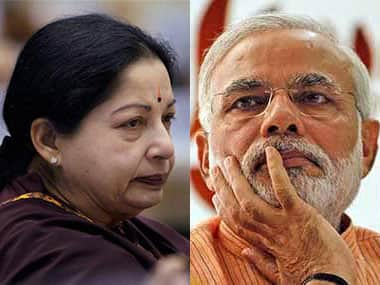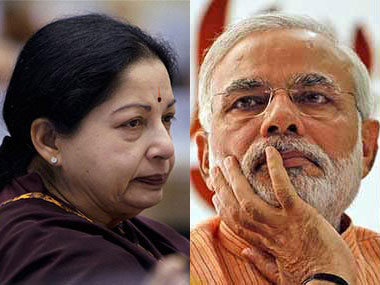Speculation has been rife that when J Jayalalithaa meets Narendra Modi in Delhi on Tuesday (3 June), the latter will ask her to join the NDA. The question is: why would Modi want a difficult ally, when he does not really need her, and especially when her entry could well constrain him in the conduct of foreign policy in respect to Sri Lanka? After all, the first political note of discord after the election was struck by Jayalalithaa, when Modi invited Sri Lankan President Mahinda Rajapakse to his swearing-in ceremony. [caption id=“attachment_1552517” align=“alignleft” width=“380”]  AIADMK Chief Jayalalithaa and Prime Minister Narendra Modi[/caption] While we cannot be sure that the Modi-Jaya meeting will result in the induction of the latter’s ministers into the cabinet, its import cannot be underestimated. Whether inside or outside, she can be a difficult person to deal with, and the prime reasoning behind Modi’s efforts to keep Jaya on his side must relate to the broader political support he needs to pass crucial legislation when the BJP (or even the NDA) lack a majority in Rajya Sabha. As things stand now, the BJP has only 46 members in Rajya Sabha, and the NDA parties have around 60-plus. Add Jaya (10), the BJD (six) and some smaller parties, and the number still will not cross 80 in a house of 238 (which additionally has 12 nominated members). The minimum numbers needed to pass any legislation in the upper house is around 120-125 MPs, assuming the nominated members can be asked to play along. The problem for the Modi government is that the UPA, in its final days, booby-trapped the economy by passing the Land Acquisition Bill – which is a huge deterrent to the growth of manufacturing and infrastructure. And reviving investment is the key to any delivery on the jobs or growth fronts. Modi simply cannot afford five more years of jobless growth. This is where Jaya’s AIADMK and even BJD’s Naveen Patnaik fit in. With 38 and 20 members in the Lok Sabha, between them Jaya and Patnaik will take the NDA’s support base to nearly 396 MPs in the lower house. This will enable the NDA, with support from friendly parties, to push key bills through in joint sittings of parliament. The Vajpayee government passed the Prevention of Terrorism Act (Pota) through a joint sitting of parliament after the Rajya Sabha defeated it in a 113-98 vote. As we noted before , while money bills, like the budget, can be passed by the Lok Sabha even if the Rajya Sabha rejects them, in the case of laws that do not relate to constitutional amendments, the assent of both the houses is mandatory. However, there are now two ways in which the BJP can overcome the Rajya Sabha hurdle – if it wants to. First, the decimation of the Congress means that some regional parties can be brought around to support NDA legislation with some kind of bargaining. In the current Rajya Sabha, the BJP has 46 seats, Shiv Sena three, TDP six, ADMK 10, BJD six, SAD three, RPI one, LJP one, INLD two and NCP six. Then there are a whole range of single-MP parties and independents. Together they add up to quite a few floating numbers. The implacable anti-BJP numbers are Congress (68), Left (11), RJD (1), BSP (14), DMK (4) and SP (9). But that’s 107 seats in a house of 250. Clearly, by offering party-specific deals and effective floor coordination, the BJP can get the required numbers in the Rajya Sabha if it really wants one. But it will be a herculean task each time. Second, the sweeping victory in the Lok Sabha for the NDA – where it could get 338 seats - will give it a majority in case the Rajya Sabha rejects any law, and a joint session of parliament has to be called to break the logjam. The two houses have a combined strength of 795, in which the BJP needs around 400-plus MPs to see bills through. It already has these numbers, but the margin is wafer thin. A few abstentions, and with some existing allies playing hard to get, each bill will be a nail-biter. Under article 118 of the constitution, the president can call a joint session of both the houses to pass any bill that is not a constitutional amendment bill. This means bills like the Food Security Bill, the Land Acquisition Bill, or other such UPA rights legislations can be overturned or amended – assuming this is something the BJP wants to do. With 338 seats in the Lok Sabha, the BJP needs only 60 votes from the Rajya Sabha in a joint setting. But with the addition of Jaya and Patnaik, it would be easier to get the numbers, even if existing allies play foul. Modi’s personal equation with Jaya will stand him in good stead. He is moving to ensure that the mandate he got is not negated by an obstructive opposition.
The BJP’s weak strength in the Rajya Sabha will be overcome once he shores up his strength in the Lok Sabha with allies like Jaya and Naveen Patnaik. In joint sitting to pass new laws, the NDA and allies can carry the day.
Advertisement
End of Article
Written by R Jagannathan
R Jagannathan is the Editor-in-Chief of Firstpost. see more


)
)
)
)
)
)
)
)
)



